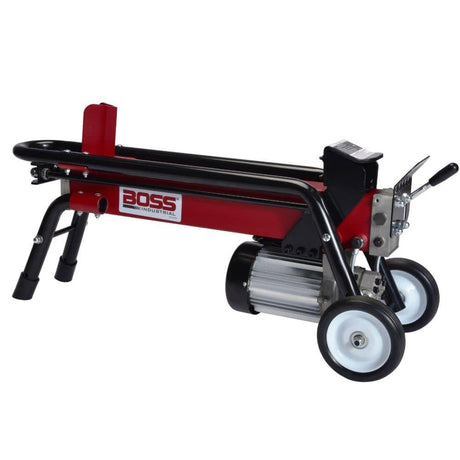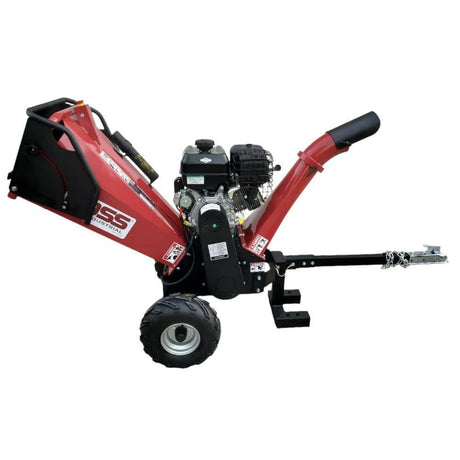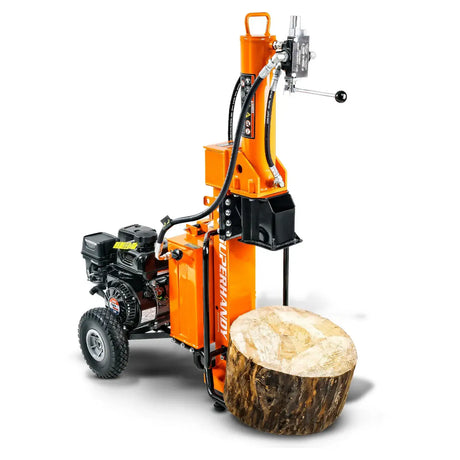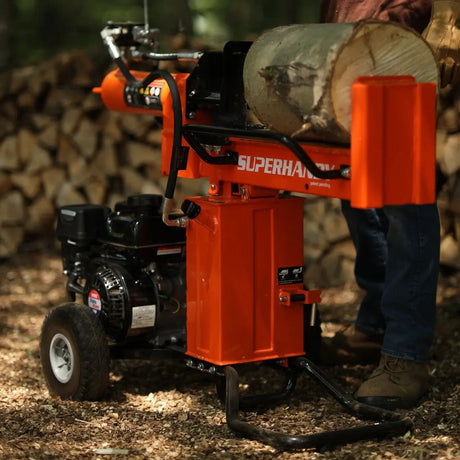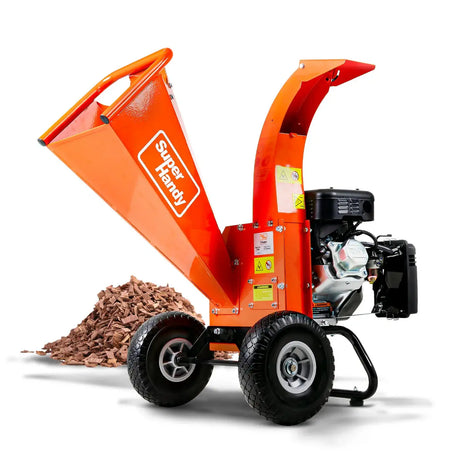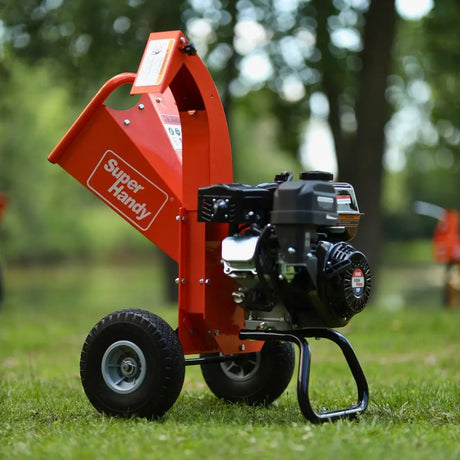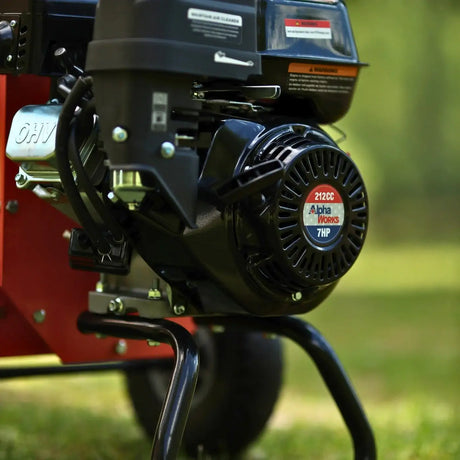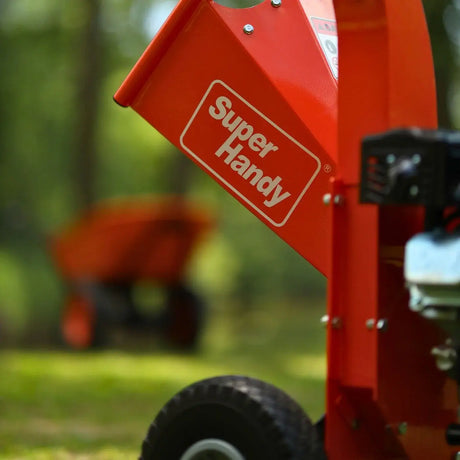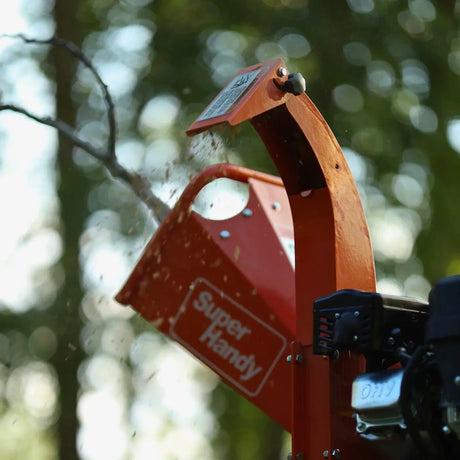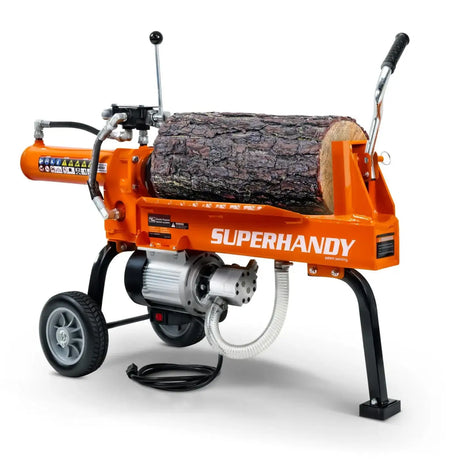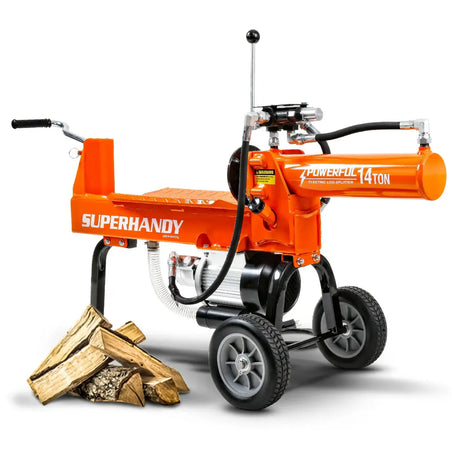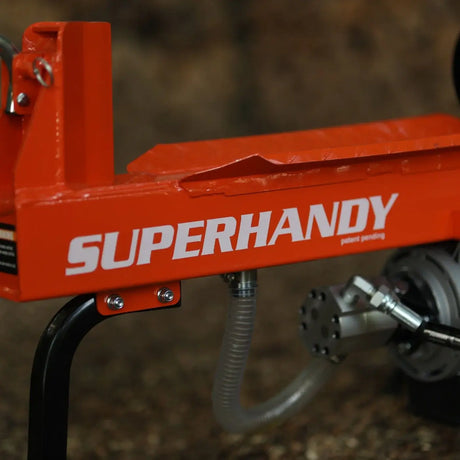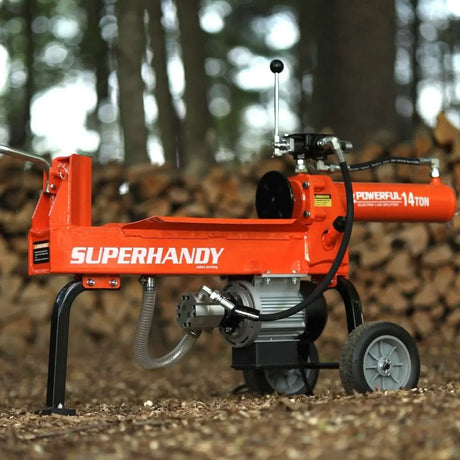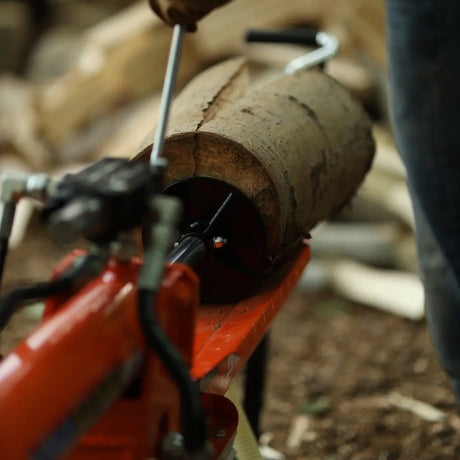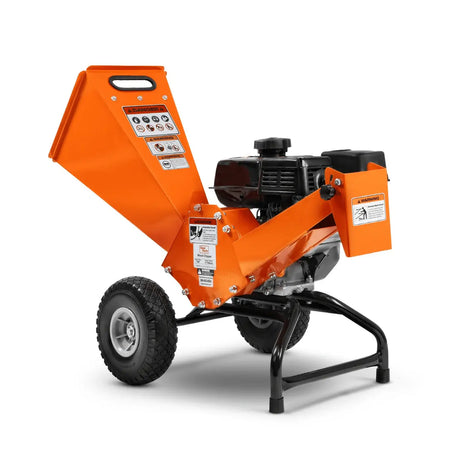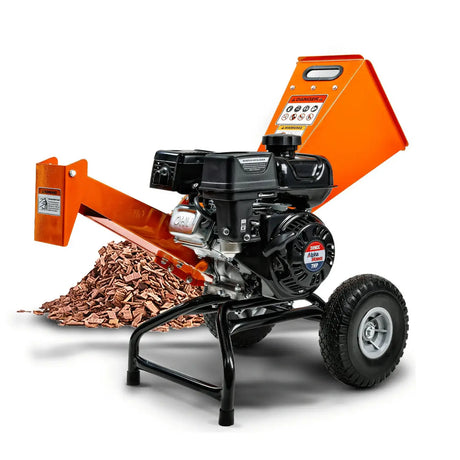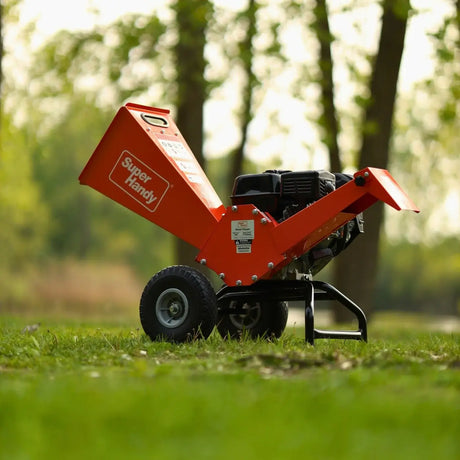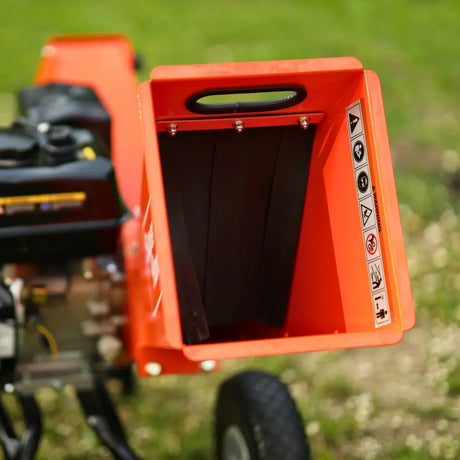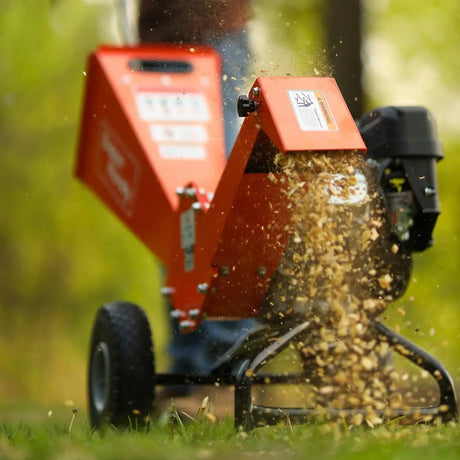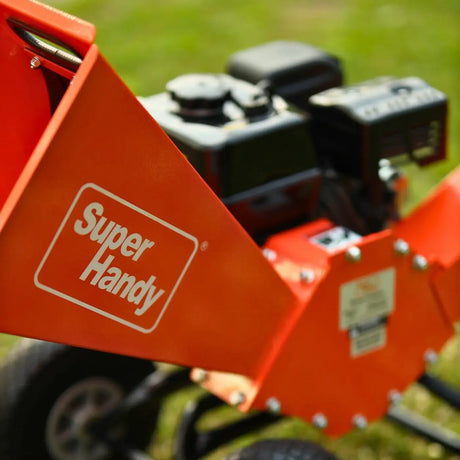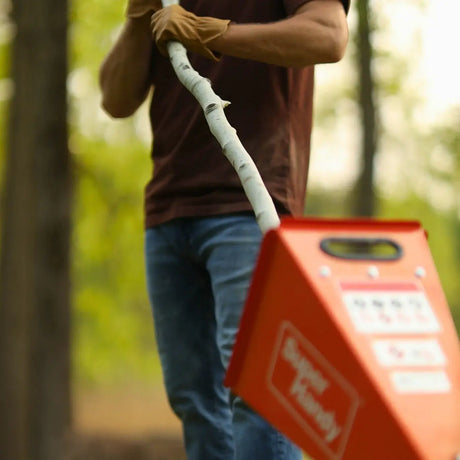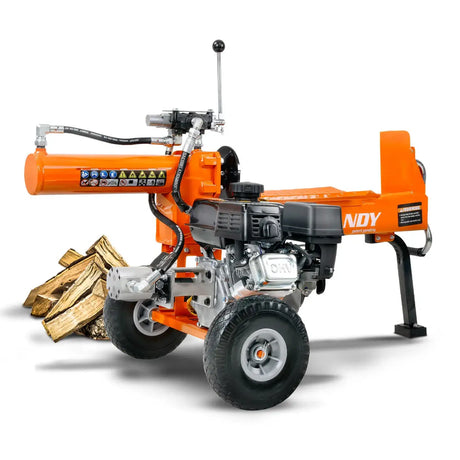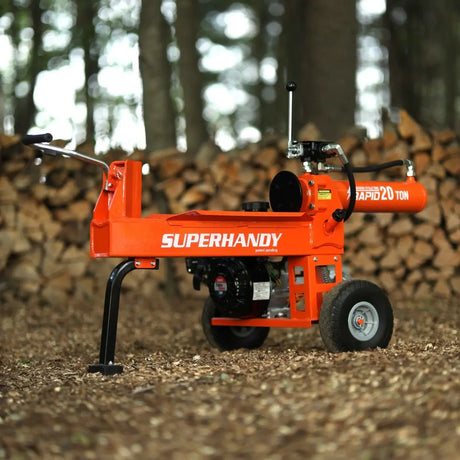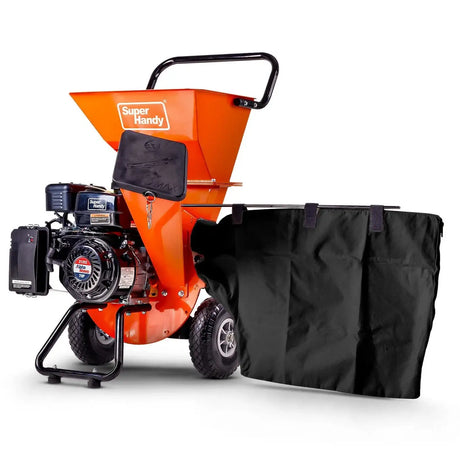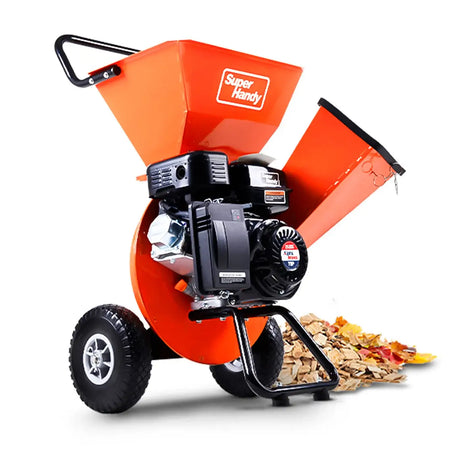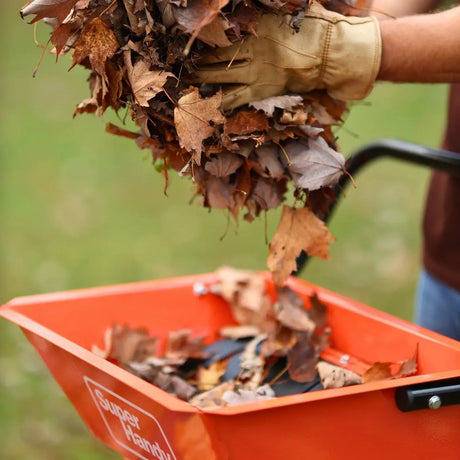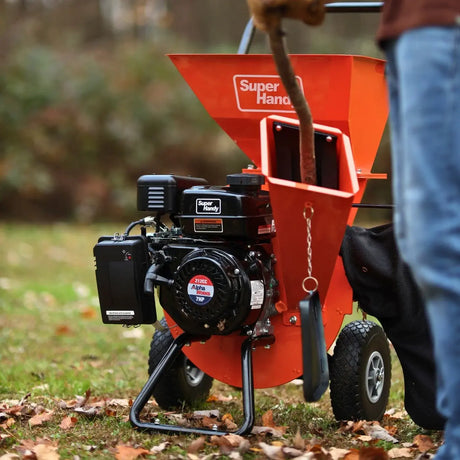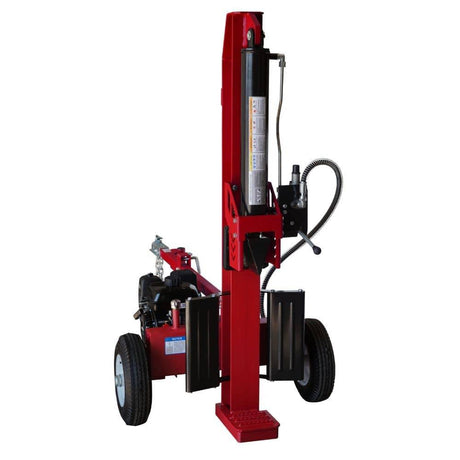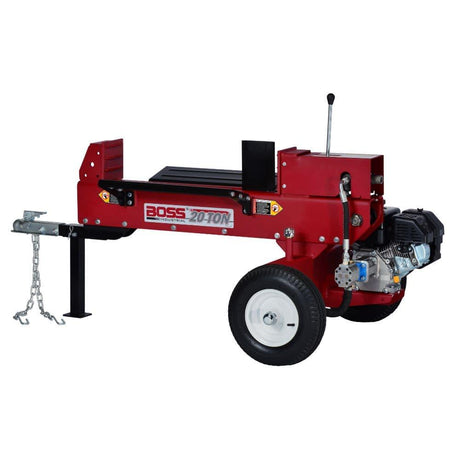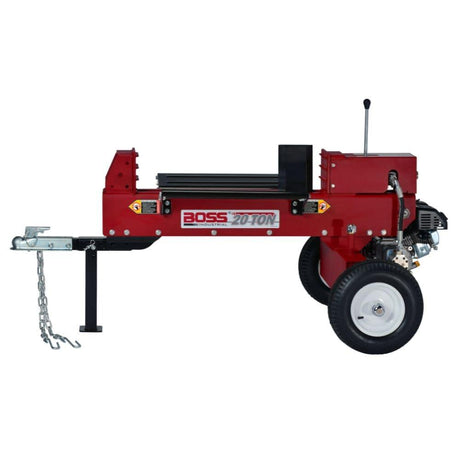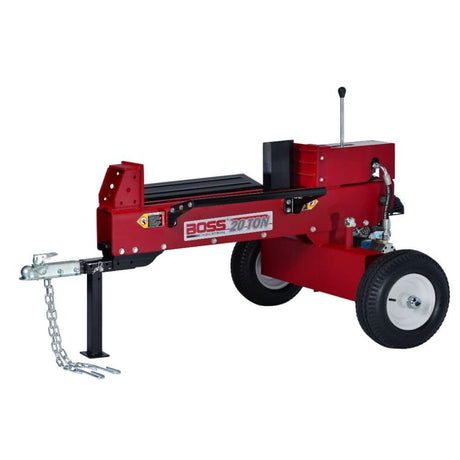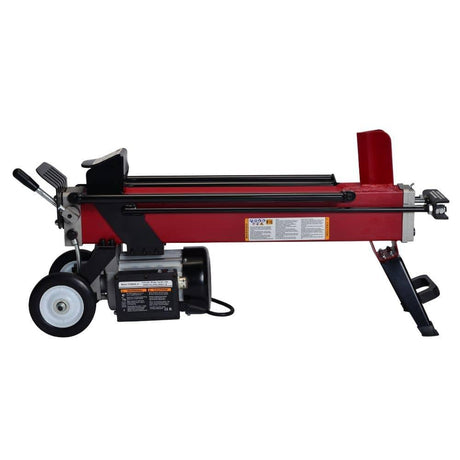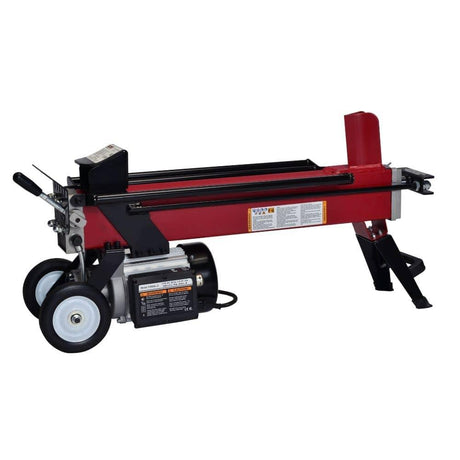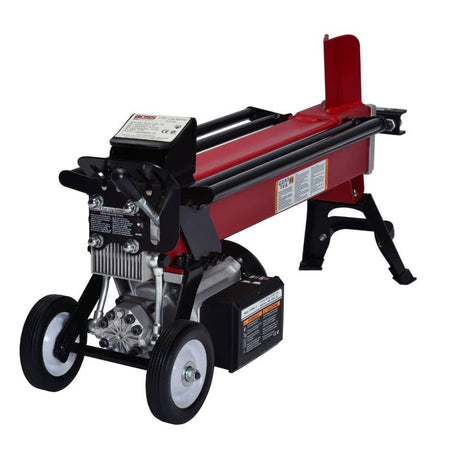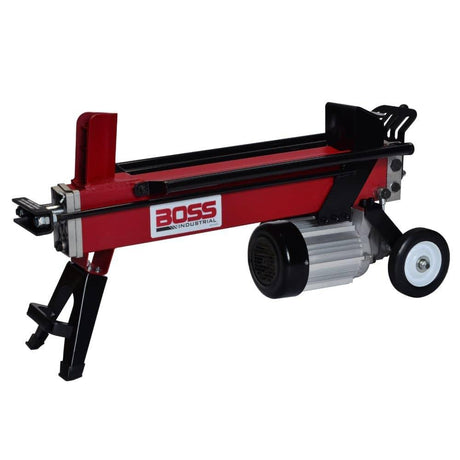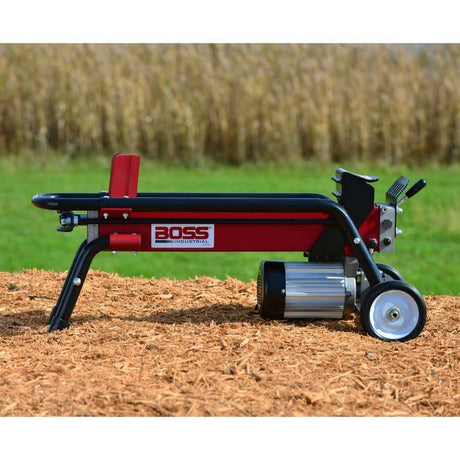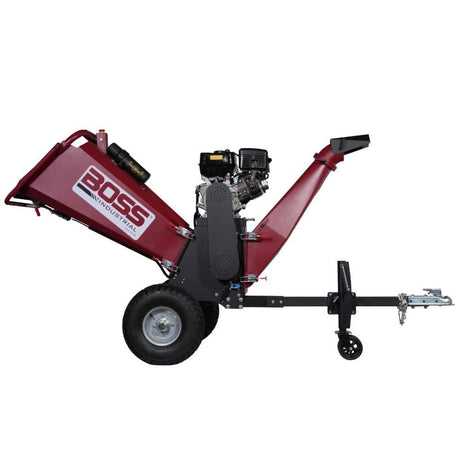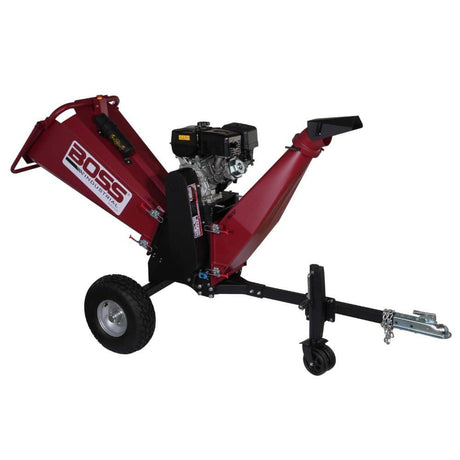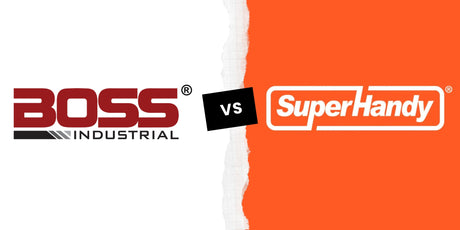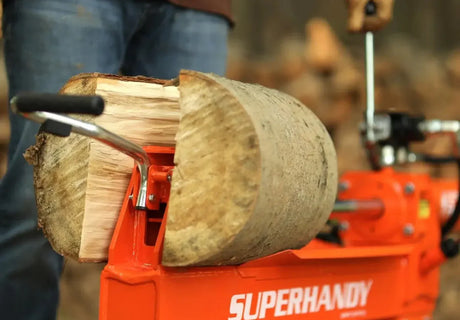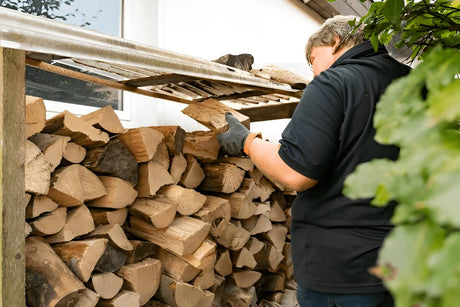Understanding Your Wood Chipper
A wood chipper is a heavy-duty machine designed to reduce wood into chippings and smaller parts, making it easier to dispose of garden waste and other wood materials. These machines come in various shapes and sizes, often mounted on wheels for easy portability. The key working part of a chipper are its blades, which rotate at high speeds to break down wood into fine chippings. The excess wood is then ejected from the machine as sawdust.
Curious about the financial side? Check out our How Much Does a Wood Chipper Cost: The Ultimate Price Guide for 2025 for detailed pricing insights.
Wood chippers are invaluable tools for anyone dealing with large amounts of yard waste. Whether you're a homeowner tidying up after a storm or a professional landscaper managing extensive properties, a wood chipper can save you time and effort by efficiently processing branches, leaves, and other debris.
Want a full overview from buying to operation and care? Check out our complete wood chipper guide to get everything you need in one place.
Why Wood Chipper Maintenance Matters
Before you dive into upkeep tips, take a look at our Wood Chippers Maintenance Checklist by Usage Hours to see exactly what to do and when.
Wood chippers aren't cheap. Whether you picked one up for weekend yard work or run a landscaping business, it's an investment. And like any hardworking equipment, it needs regular care to stay reliable.
Neglect might not seem like a big deal at first, but over time, it leads to dull blades, engine trouble, and dangerous operating conditions. You wouldn't drive your truck 20,000 miles without an oil change-same deal with your chipper. It's crucial to know your machine inside and out. Always refer to the owner's manual for specific maintenance and lubrication instructions to ensure your machine operates efficiently and effectively.
Here's why staying on top of maintenance is worth every minute of effort.

Safety Precautions
Wood chippers are powerful machines that can cause serious harm if not used correctly. Safety gear and personal protective equipment (PPE) are essential when operating a wood chipper. This includes wearing gloves, safety glasses, ear protection, and sturdy clothing to protect against flying debris.
It's crucial to know your machine inside and out. Familiarize yourself with the owner's manual and understand all safety features and operating procedures. Always perform a thorough inspection of the machine before use to ensure everything is in working order.
If you’re new to using this equipment, here’s a complete guide on how to use a wood chipper safely and efficiently.
For added safety, it's recommended to have two people operate the wood chipper. One person should be near the kill switch at all times, ready to shut off the machine in case of an emergency. Regularly inspecting the machine and adhering to safety protocols can prevent accidents and ensure a safe working environment.
Extend the Life of Your Equipment
Wood chippers are built tough, but they're not invincible.
Routine maintenance-checking blades, changing oil, cleaning debris-gives your machine a real shot at lasting for years. I've seen homeowners keep theirs running for a decade with basic care. I've also seen nearly new chippers ruined in one season from pure neglect.
Maintenance prevents small problems from becoming major ones, like:
- Dull blades that overwork the motor, leading to overheating
- Clogged chutes that strain and damage moving parts
- Dry bearings that seize and cause costly breakdowns
Proper maintenance can significantly extend the service life of your wood chipper, ensuring it remains functional and efficient for a longer period.
And if you ever plan to resell your chipper, proper upkeep holds its value.
Prevent Downtime and Costly Repairs
Nothing kills a productive day like a chipper that won't start.
Say you've cleared a Saturday to chip up storm debris. You go to start the machine… and nothing. Or worse, it sputters out mid-job. Most of the time, it's something simple-old spark plugs, a dirty air filter, or gummed-up fuel lines.
And those quick fixes? They're a lot cheaper than what happens if you ignore them:
- Skipping an oil change can lead to engine damage ($300+)
- Loose belts can snap mid-job (another $100+)
- Letting a chipped blade go too long means replacing the whole set
Routine maintenance is your insurance policy against inconvenient-and expensive-breakdowns.
For a focused maintenance schedule broken down by usage hours, see our Wood Chippers Maintenance Checklist by Usage Hours.
Stay Safe While Operating Heavy Machinery
Wood chippers are powerful tools with rotating blades and high torque. If something's off, things can go south fast.
Maintenance directly impacts safety. A jammed feed system can pull in material unpredictably. Dull blades cause kickback. And if the emergency stop or safety collars fail, you're putting yourself-or your crew-at real risk.
One landscaper I know had a close call when the anvil bolts loosened mid-job. Luckily, he caught the vibration early. A quick inspection saved him from injury and a hefty repair bill.
Regularly inspecting the machine and adhering to safety protocols can prevent accidents and ensure a safe working environment. Additionally, using a push stick to safely feed stubborn branches into the chipper can prevent damage to the machine and reduce the risk of personal injury.
For a full breakdown of how to stay safe during every stage of operation, read our essential wood chipper safety tips before your next job.
A well-maintained chipper is a safer chipper.
Pre-Operation Checks
Before operating a wood chipper, it's essential to ensure the machine is properly maintained. Start by checking the air filter and cleaning or replacing it if necessary. A clean air filter ensures the engine runs smoothly and efficiently.
Next, inspect the belt tension and adjust it according to the owner's manual. Proper belt tension is crucial for the machine's performance and longevity. Check the blade bolts to ensure they are tightened securely, as loose bolts can lead to dangerous malfunctions.
Additionally, examine the electrical components for any signs of damage. Ensuring that all parts are in good condition and the machine is properly maintained will help prevent breakdowns and ensure safe operation.

Wood Chipper Maintenance Checklist (With Timeline)
Keeping up with maintenance is what separates a smooth-running chipper from one that gives up mid-job. Breaking tasks down by timeline makes upkeep manageable and keeps your machine in top shape, whether you use it every weekend or just a few times a year.
After Each Use
- Clear out any debris from the hopper and discharge chute.
- Wipe down exposed metal to prevent corrosion.
- Use a pressure washer to clean the wood chipper thoroughly, but be cautious to avoid sensitive components like the engine and electrical parts to prevent damage.
- Check the blades for any signs of wear or damage.
- Ensure all bolts and screws are tight.
Before Each Use
Think of this as your pre-trip check. It only takes a few minutes, but it goes a long way.
What to do:
- Inspect blades for nicks, cracks, or dullness
- Check oil level-low oil is a leading cause of engine wear
- Examine the air filter-clean or replace if dusty or clogged
- Scan for loose bolts or hardware from vibration
- Look for leaks or debris buildup around the housing
If anything looks off, fix it before starting. It's easier to catch issues early than deal with breakdowns later.
After Each Use
A quick post-job cleanup keeps rust, residue, and clogs from building up.
Post-use best practices:
- Clean out the hopper and chute to prevent moisture buildup
- Clear sap and bark from blades and housing
- Remove debris from belts, blades, and wheels
- Wipe down exposed metal to prevent corrosion
Tip: If you've chipped wet or sappy wood, lightly spray the blades with lubricant to stop resin from hardening.
Weekly or Every 10 Hours of Use
For regular users, this is your essential maintenance rhythm.
Check and maintain:
- Blade sharpness-dull blades slow you down and stress the engine
- Grease bearings and fittings to prevent overheating
- Adjust belt tension-too loose or too tight both cause damage
- Check tire pressure and lug nuts on towable units
If you feel extra vibration or uneven chipping, inspect blades and belts.

Monthly or Every 25-50 Hours
Time for a deeper tune-up to keep things running clean and safe.
What to do:
- Change engine oil-most small engines need it every 25 hours
- Deep clean or replace the air filter, especially in dusty conditions. Keeping air filters in good condition is vital for maintaining peak engine performance and protecting the machine from dust and debris.
- Replace the spark plug if worn or fouled
- Test all safety features-emergency stops, guards, and feed mechanisms
- Recheck bolts, especially around the blade assembly
A well-tuned machine performs better-and keeps you safer.
Seasonal or Annual Maintenance
Whether your chipper's been idle or working hard, this gets it ready for long-term storage or heavy seasonal use.
Your seasonal checklist:
- Drain old fuel or add stabilizer to avoid gummed-up carburetors
- Replace blades if they're worn past the second or third sharpening
- Flush and refill engine and hydraulic fluids (if applicable)
- Deep clean with compressed air or a soft brush
- Store indoors or under a breathable tarp, off the ground
- Review your maintenance log to spot wear patterns
Story time: A homeowner once called in a panic because their chipper wouldn't start in spring. The culprit? Fuel left in the tank all winter. One $4 bottle of stabilizer could've saved them a $150 carburetor repair.
Engine Maintenance
Regular maintenance of the engine is necessary to ensure optimum performance of your wood chipper. Before running the machine, always check the engine oil level and top it off as needed. Using the recommended engine oil for your specific engine type is crucial for maintaining its health and efficiency.
Change the engine oil regularly, following the guidelines in the owner's manual. This helps to keep the engine running smoothly and prevents wear and tear. Additionally, check the air filter and clean or replace it as needed to ensure proper airflow and engine performance.
By keeping up with these routine maintenance tasks, you can extend the life of your wood chipper and ensure it operates at its best.
If you need a refresher on safe operation before diving into maintenance, review our How to Use a Wood Chipper: Guide for Homeowners and Pros.

Troubleshooting Common Wood Chipper Problems
Even a well-maintained chipper will act up eventually. These machines take a beating, especially when processing thick limbs and yard waste. The key is catching issues early-before they derail your day.
Here are the most common problems I've seen in the field, and how to fix them.
Chipper Won't Start
This is the #1 issue I hear: "It worked last week-now nothing."
Start with this quick checklist:
- Fuel: Is the tank full and the gas fresh? Old fuel gums up the carburetor.
- Spark plug: Check for deposits or damage. Make sure it's properly gapped.
- Oil level: Many engines won't start if the oil is low.
- Air filter: A clogged filter restricts airflow and blocks ignition.
- Safety switches: Some chippers won't run if guards are open or the hopper isn't latched.
If all else checks out, it may be time to clean the carburetor or replace the ignition coil-but most cases are resolved before that point.

Poor Chipping Performance or Clogging
If it's running but not chipping well-or jamming constantly-something's off.
Common causes:
- Dull blades: If material tears instead of slicing, sharpen or flip the blades.
- Wet or stringy debris: Leaves, vines, and saplings can gum things up. Mix in dry branches.
- Clogged chute: Clear built-up chips or sap with a tool-never your hands.
- Underpowered engine: Could be dirty air filter, old fuel, or a loose belt.
- Poor feeding technique: Don't overload the hopper or force too much at once.
Pro tip: Damp pine needles and soft material clog fast. Alternate soft with dry, harder wood for smoother output.
Unusual Noises or Vibration
Your chipper makes noise-but abnormal rattling or screeching is a red flag.
Check for:
- Loose bolts or guards: Vibration can shake parts loose.
- Damaged blades: A bent blade throws off balance and causes shaking.
- Debris in the housing: Rocks or chunks near the rotor can grind or thump.
- Worn bearings: Screeching or growling sounds often point to bearing failure.
Excess vibration isn't just annoying-it shortens lifespan and creates safety risks. Shut it down and inspect before continuing.
Excessive Smoke or Fuel Smell
Different smoke colors and fuel smells point to specific issues:
- White smoke: Often oil burning-check for overfilled oil or bad engine seals.
- Black smoke: Too much fuel-clean the air filter and check carb settings.
- Strong fuel smell: May indicate a leak-inspect hoses, fittings, and the carburetor bowl.
If fuel is leaking while the engine's hot, shut it down and let it cool before inspecting. Safety first.
Blade Damage or Frequent Dullness
Sharpening too often or noticing chips in the blade? You might be feeding it wrong.
Common causes:
- Hard objects: Stones or nails in branches damage blades fast.
- Feeding too quickly: Overloads stress both blades and anvil.
- Improper sharpening: Using the wrong tools can dull blades prematurely.
To reduce blade wear:
- Inspect material before chipping, especially construction debris
- Use a sharpening guide or hire a pro
- Keep the anvil in good condition-dull anvils strain the blade
If blades wear out every few jobs, reevaluate what and how you're feeding the machine.
Bottom line: Most wood chipper problems aren't complicated-they're mechanical symptoms with simple fixes. Learn to spot them early, and your chipper will stay powerful and reliable job after job.

Operating in Cold Weather
Operating a wood chipper in cold weather requires special precautions to ensure the machine runs smoothly and safely. First, make sure the machine is properly maintained and in good working condition before use. Using a cold-weather engine oil can help ensure proper lubrication and prevent engine issues.
Take regular breaks to allow the machine to warm up and prevent overheating. Cold weather can cause the engine to work harder, so giving it time to rest is important. Be aware of the potential for ice and snow to accumulate on the machine, and take steps to prevent it, such as clearing off any buildup before starting the chipper.
By following these tips, you can safely and effectively use your wood chipper even in cold weather conditions.
Pro Tips for Long-Term Wood Chipper Care
Keeping a wood chipper running like new isn't just about oil changes and blade sharpening. Over the years, I've found that those who get the most out of their machines follow a few smart long-term habits-practices that go beyond the basics and keep equipment reliable for years.
Use Only Genuine Replacement Parts
Cheap parts might seem like a deal, but they often don't match your chipper's tolerances-and they can compromise safety.
Why genuine parts matter:
- Designed for proper fit and performance
- Maintain safety ratings, especially for high-speed parts like blades and belts
- Offer better durability and reliability
One client used a discount blade that snapped on the first job, damaging the machine and narrowly avoiding injury. Spend a little more now, and save yourself bigger problems later.
Keep a Maintenance Log
Tracking your chipper's history helps prevent repeat issues and makes troubleshooting easier.
What to track:
- Oil changes
- Blade sharpening or replacement
- Belt and pulley adjustments
- Greasing and lubrication
- Filter and spark plug changes
- Notable noises, leaks, or breakdowns
One client kept losing belts every 12-15 hours. His log helped us trace the issue to a misaligned pulley-and fix it for good.
Store Your Chipper Properly
Poor storage is a silent killer. Many spring issues come from rust, stale fuel, or dried-out seals.
For short-term storage:
- Clean off debris and moisture
- Dry the chute and exposed metal
- Store in a covered, dry location-off the ground if possible
For long-term or seasonal storage:
- Drain the fuel or use stabilizer
- Change the oil and clean or replace the air filter
- Add a drop of oil into the cylinder and slowly crank to coat internals
- Cover with a breathable tarp-avoid plastic covers that trap moisture
- Elevate tires off concrete to prevent dry rot
A properly stored chipper starts clean and runs strong. A neglected one costs you time and repairs.
Educate All Users on Proper Handling and Safety
If multiple people use your chipper, make sure they know what they're doing. Most preventable damage comes from user error.
Make sure users know:
- How to check oil and fuel
- How to feed material correctly (butt-first, no overloading)
- Where the emergency shut-off is-and how to use it
- What not to feed the chipper (rocks, metal, tangled vines)
- How to recognize blade or belt wear
A five-minute walkthrough can prevent costly mistakes-or injury.
Schedule a Professional Tune-Up Annually
Even with great daily care, an annual checkup catches deeper wear before it turns into real trouble.
A good tune-up includes:
- Blade sharpening or replacement
- Belt inspection and adjustment
- Bearing greasing and testing
- Engine diagnostics
- Carburetor tuning
- Safety system inspection
If your machine is under warranty, a pro tune-up may be required to keep it valid.
Final Thought
Treat your chipper like a disposable tool, and it won't last. Treat it like a precision machine-quality parts, smart storage, regular service-and it'll keep working hard for years. These habits aren't just about maintenance-they're about respect for your equipment. And that respect always pays off.

Choosing a Low-Maintenance Wood Chipper (If You're Buying)
If you're looking for a wood chipper that's easy to maintain, you're not alone. It's one of the most common questions I get: "What's the lowest-maintenance chipper?"
The truth? Some are built with maintenance in mind-others will have you constantly wrenching. Here's what to consider before buying.
Electric vs. Gas: Maintenance Differences
Your power source plays a big role in how much upkeep your chipper will need.
Not sure which type fits your needs long-term? Check out our full electric vs. gas wood chipper comparison to see the pros and cons of each before you buy.
Electric Wood Chippers
Lower-maintenance and simpler by design.
Pros:
- No oil changes or fuel issues
- Quieter and easier to start
- Fewer moving parts
Cons:
- Lower power and capacity
- Limited by cord or battery
- Not ideal for thick branches
Great for homeowners handling light yard work-just make sure it matches your needs.
Gas-Powered Wood Chippers
More power, but more components to care for.
Pros:
- Handles larger branches and frequent use
- Greater mobility and durability
Cons:
- Requires engine, oil, and belt maintenance
- Heavier, louder, and bulkier
Ideal for pros, rural property owners, or anyone clearing heavy brush regularly.
What to Look for in a Low-Maintenance Model
Whatever type you choose, these features will make upkeep easier:
-
Easy-Access Blade Housing Tool-free or quick-access covers make blade maintenance painless.
-
Reversible or Hardened Blades Reversible blades double lifespan. Hardened steel holds an edge longer.
-
Self-Feeding or Auto-Feed Systems Reduces user fatigue and helps prevent jams.
-
Built-In Safety Features Emergency stops, safety collars, and auto-stops protect both users and machines.
-
Solid Discharge Design Wide or angled chutes jam less and are easier to clear.
-
Quality Bearings and Lubrication Points Well-placed grease fittings and sealed bearings reduce friction and extend life.
-
Reliable Brand with Available Parts Choose a brand that offers easy access to parts and manuals. (YardBeast, Super Handy, and Boss Industrial are solid picks.)
Best Practices When Buying Used Equipment
Used chippers can save money-but only if you know what to look for.
Key checks:
-
Blades and Anvil - Look for nicks, dullness, or uneven wear. Anvil should be solid and aligned.
-
Cold Start - Ask the seller to start it cold. Hard starts, rough idling, or smoke can signal deeper issues.
-
Noise or Vibration - Rattling, grinding, or shaking may mean loose parts or worn components.
-
Belts and Pulleys - Cracked belts or damaged pulleys are red flags.
-
Maintenance History - No record? That's a warning sign.
-
Frame and Chassis - Rust or weld repairs may point to heavy use or poor storage.
Final tip: Bring a mechanic or ask a dealer to inspect it. A small fee now can save big later.
In short: Choosing a low-maintenance chipper comes down to knowing how much you'll use it, what you'll feed it, and how much upkeep you're willing to do. The right machine should fit your work style-not complicate it.
Choose smart now, and your chipper will work hard for years-with minimal fuss.



